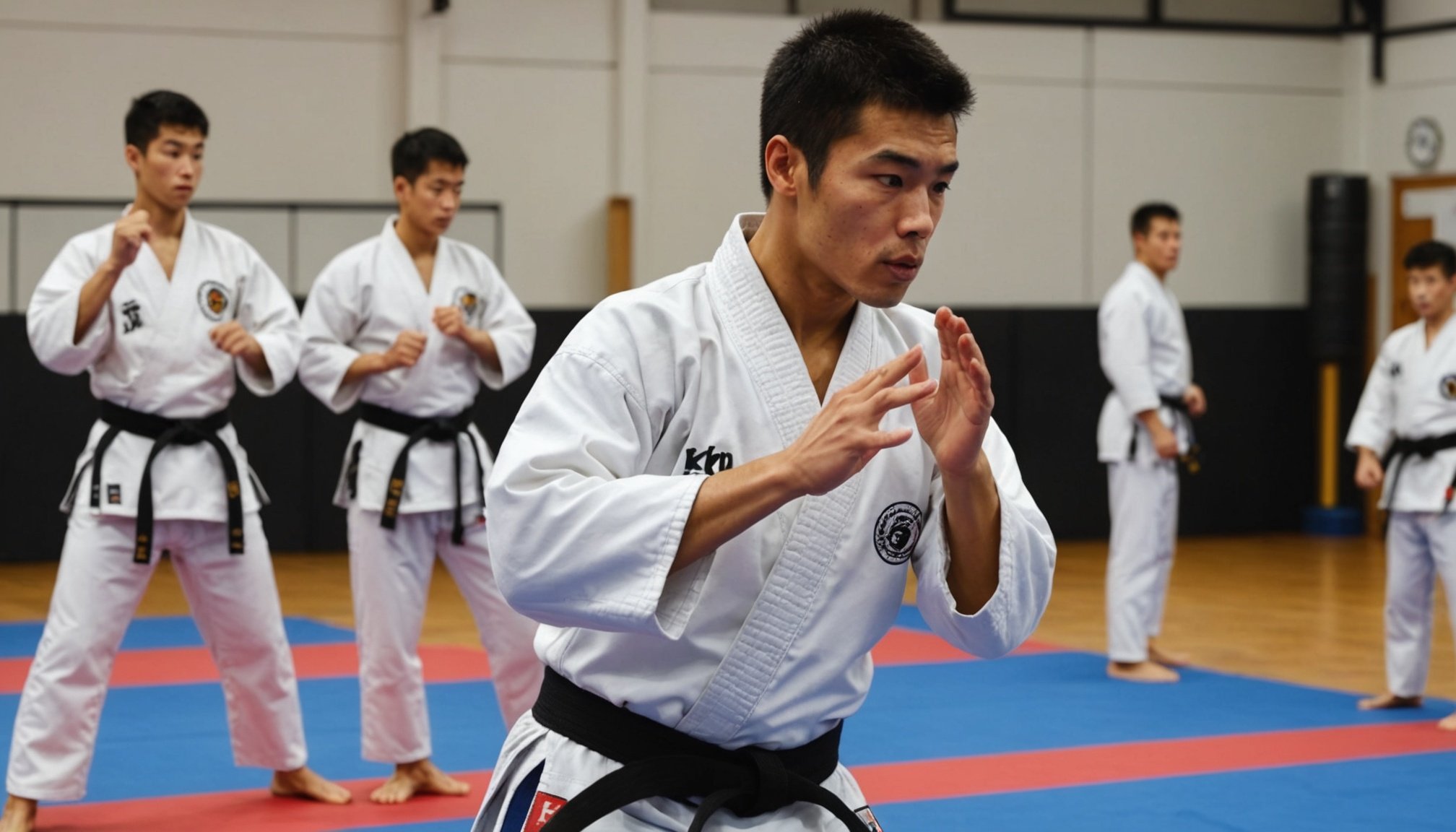Top Breathing Techniques for UK Karate Competitors: Boosting Performance and Focus
The Importance of Breathing in Karate
When it comes to martial arts, particularly karate, breathing is often overlooked but is crucial for optimal performance. Effective breathing techniques can enhance endurance, reduce stress and anxiety, and improve overall health. For UK karate competitors, mastering these techniques can be the difference between winning and losing.
Breathing and Oxygen Advantage
Breathing is the foundation of any physical activity, and in karate, it is no exception. The body’s ability to utilize oxygen efficiently is known as the “oxygen advantage,” a concept popularized by Patrick McKeown, a renowned breathing expert. By optimizing breathing, athletes can improve their oxygen intake, which in turn enhances their performance.
This might interest you : Exploring the Hottest Aerobic Conditioning Trends for Kickboxers in the UK
"Proper breathing is essential for maintaining focus and composure during intense training and competition," says Hiroshi Shirai, a former JKA Grand Champion and influential figure in Shotokan Karate.
Key Breathing Techniques for Karate Competitors
Here are some of the most effective breathing techniques that karate competitors can incorporate into their training:
1. Diaphragmatic Breathing
Also known as belly breathing, this technique involves using the diaphragm to expand the lungs fully. This type of breathing is more efficient than shallow chest breathing and helps in reducing stress and anxiety.
Also to read : Essential Safety Guidelines for Sparring in UK Taekwondo Clubs: Protecting Practitioners First!
- How to Practice: Lie on your back, place one hand on your stomach and the other on your chest. Inhale deeply through your nose, allowing your stomach to rise while your chest remains still. Exhale slowly through your mouth, letting your stomach fall.
2. Box Breathing
This technique is simple yet powerful. It involves breathing in for a count of four, holding for a count of four, exhaling for a count of four, and holding again for a count of four.
- How to Practice: Sit comfortably or stand with your back straight. Inhale for four seconds, filling your lungs completely. Hold your breath for four seconds. Exhale for four seconds, emptying your lungs completely. Hold your breath again for four seconds.
3. Hof Breathing Method
Popularized by Wim Hof, this method involves rapid and deep breathing followed by brief periods of breath holding. This technique can increase oxygen levels in the body and reduce carbon dioxide.
- How to Practice: Sit comfortably and breathe in deeply through your nose, then exhale through your mouth. Repeat this process rapidly for about 30 breaths. After the last exhalation, hold your breath for as long as you can. When you need to breathe again, inhale deeply and hold for 10-15 seconds.
Breathing Exercises in Karate Training
Breathing exercises should be an integral part of any karate training regimen. Here’s how you can incorporate these techniques into your daily practice:
Warm-Up and Breathing
Before starting any intense physical activity, a proper warm-up is essential. This includes light jogging, joint mobility exercises, and dynamic stretches. Incorporating breathing exercises during the warm-up can prepare the body for the upcoming physical demands.
"We start every class with arm and leg stretches, followed by a block of exercise. Then we run through our basics, including punches, stances, and blocks, all while focusing on proper breathing techniques," explains a karate instructor from Cambridge Karate Dojo.
Breathing During Techniques
During karate techniques such as kihon (basic movements), kata (forms), and kumite (sparring), breathing plays a critical role. Proper breathing helps in maintaining balance, generating power, and reducing fatigue.
- Example: When performing a punch, inhale as you chamber your fist and exhale as you extend it. This synchronization of breath with movement enhances the technique’s effectiveness.
Benefits of Breathing Techniques for Karate Competitors
Physical Benefits
Improved Endurance
Efficient breathing techniques help in optimizing oxygen intake, which is crucial for high-intensity activities like karate. This improves endurance, allowing competitors to perform at their best over longer periods.
Enhanced Blood Flow
Proper breathing helps in maintaining healthy blood flow, which is essential for delivering oxygen and nutrients to the muscles. This reduces the risk of fatigue and injury.
Increased Red Blood Cells
High-altitude training and certain breathing techniques can increase red blood cell production, which enhances the body’s ability to transport oxygen to the muscles.
Mental Benefits
Reduced Stress and Anxiety
Breathing techniques such as diaphragmatic breathing and box breathing are known to reduce stress and anxiety. This mental clarity is crucial for competitors to stay focused during high-pressure events.
Improved Mental Health
Regular breathing exercises can contribute to better mental health by reducing symptoms of depression and anxiety. This overall mental well-being is vital for athletes to perform at their peak.
Practical Tips for Incorporating Breathing Techniques
Here are some practical tips to help you integrate these breathing techniques into your karate training:
Create a Breathing Routine
- Start Small: Begin with short sessions of breathing exercises and gradually increase the duration as you become more comfortable.
- Consistency: Make breathing exercises a part of your daily routine, whether it’s during your warm-up, cool-down, or even during breaks.
Use Breathing During Training
- Synchronize Breathing with Movements: Practice breathing in sync with your karate techniques to enhance their effectiveness.
- Focus on Breathing During Rest: Use rest periods to practice deep breathing exercises to help your body recover faster.
Monitor Your Progress
- Track Your Performance: Keep a log of your training sessions and note how breathing techniques affect your performance.
- Seek Feedback: Ask your instructor or training partners for feedback on your breathing during training.
Table: Comparison of Breathing Techniques
| Breathing Technique | Description | Benefits | How to Practice |
|---|---|---|---|
| Diaphragmatic Breathing | Uses the diaphragm to expand the lungs | Reduces stress, improves oxygen intake | Lie on your back, inhale deeply through your nose, allowing your stomach to rise |
| Box Breathing | Inhale for 4 seconds, hold for 4 seconds, exhale for 4 seconds, hold for 4 seconds | Improves focus, reduces anxiety | Sit comfortably, inhale for 4 seconds, hold for 4 seconds, exhale for 4 seconds, hold for 4 seconds |
| Hof Breathing Method | Rapid deep breathing followed by brief breath holding | Increases oxygen levels, reduces carbon dioxide | Sit comfortably, breathe in deeply through your nose, then exhale through your mouth rapidly for 30 breaths, hold your breath after the last exhalation |
| Altitude Training | Training at high altitudes to increase red blood cell production | Enhances endurance, increases red blood cells | Train at high altitudes or use a hypobaric chamber |
Breathing techniques are a powerful tool for karate competitors looking to enhance their performance and focus. By incorporating diaphragmatic breathing, box breathing, and the Hof breathing method into their training, athletes can improve their endurance, reduce stress and anxiety, and overall health. Remember, consistent practice and proper technique are key to reaping the full benefits of these breathing exercises.
"Breathing is the foundation of all physical activities. It is what sets the great athletes apart from the good ones," says Patrick McKeown, emphasizing the importance of breathing in sports performance.
By integrating these techniques into your training regimen, you can unlock your full potential and achieve greater success in the world of karate. So, take a deep breath, focus, and let your training begin.











